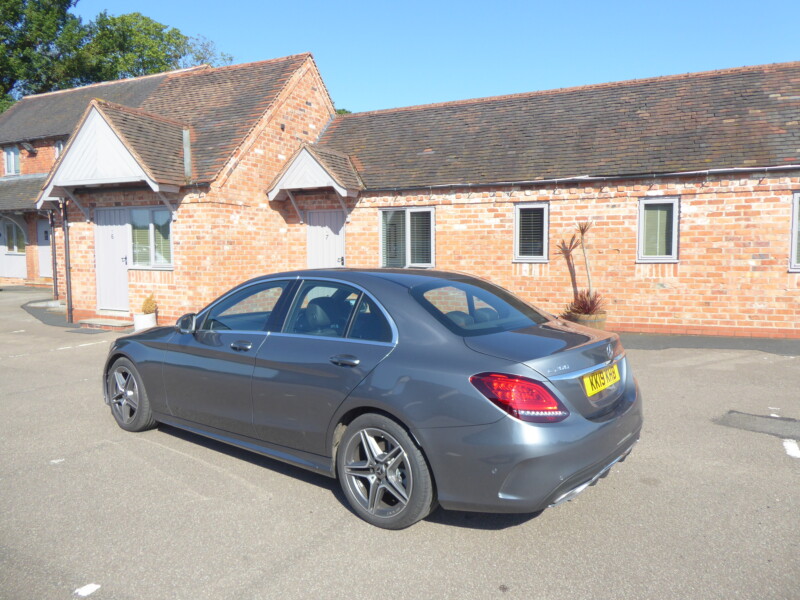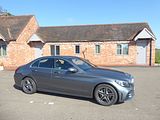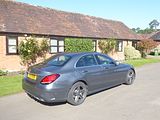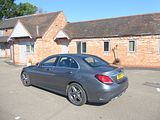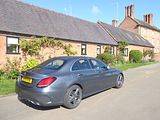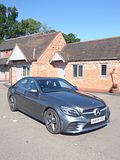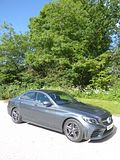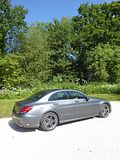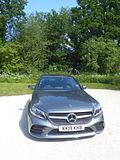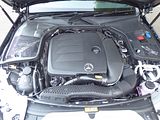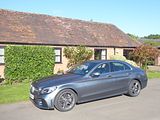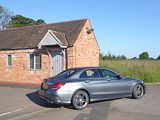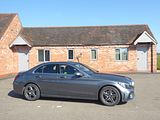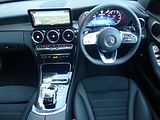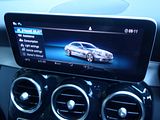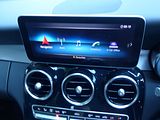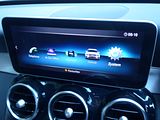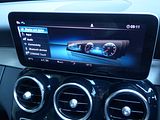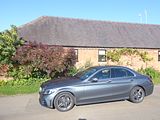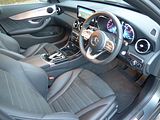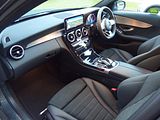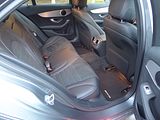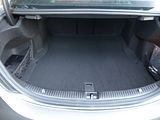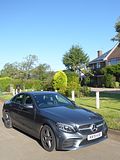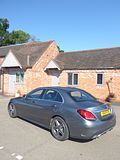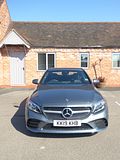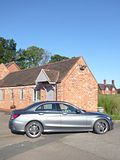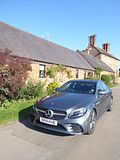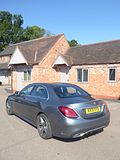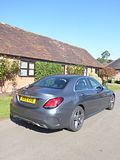With sales of over 9.5 million units, the C Class is an important car for Mercedes and one which currently accounts for roughly 1 in 5 sales of cars with the three-pointed star. Mercedes launched the current generation of the C Class at the end of 2013, with sales starting in most markets around the world during 2014. The initial range quickly grew and additional body styles were added, with four choices now available: four door saloon, estate, two door coupe and a stylish convertible. An almost bewildering array of petrol and diesel engines have been offered in the model, and whilst the looks of the W205 generation car have changed only slightly with the mid cycle refresh of 2018, the engine options have seen more change. I’ve now sampled a number of this generation of the C Class, in the USA and Italy, experiencing the saloon, estate and convertible bodies and three different engines. With this test comes a UK market car and a different engine, again. This one was a rental car, and I was quite surprised to find that unlike most rental cars of this price and class, it came with a petrol engine and not the expected diesel. I guess that is an indication of how the market is moving away from diesel-powered cars. It also featured the AMG Line trim which Mercedes introduced as the equivalent to the popular M Sport trim of BMW and S Line of Audi. The C Class may sell in large numbers but it always has a battle on its hands with the 3 and 4 Series and A4/A5 proving formidable competitors. And they are not the only ones, with Alfa Romeo, Jaguar, Lexus and Volvo also offering premium-badged cars of this size. My previous tests of C Class cars have always found something that was generally pleasant but which lacked the final edge to be the clear class leader. How would the C200 AMG Line fare? Read on.
Identifying the version I had received was easy as a badge on the boot (and the rental car paperwork) told me that this was a C200. That makes it a step above the entry level petrol car, the C180. Unusually, the C200 actually has a smaller engine than the C180. It is a 1.5 litre turbo 4, which generates 184 bhp. There is a mild hybrid EQ system. Were it not for the gauge in the lower part of the instrument cluster, you really would not know as the systems just works in the background, with the gauge telling you when there is a battery assist and when the battery is being charged by the engine or braking. You can’t run the car just on battery power, so this is more around giving an assist to the engine with some extra oomph and some reduced CO2s. Despite its four cylinders the engine in this car was very smooth. There’s a slight roar which gives a sporty sound to it, though the reality is that, despite that AMG Line badging, this is more brisk than fast. The 9 speed gearbox is well matched to the engine, and provides seamless shifts of ratio without you really realising that it is doing so. There are paddles on the steering wheel, but you will struggle to change gear as well as the car does so itself. The upper ratios are quite close together, with 8th and 9th only really useful for steady speed cruising on the motorway, but this Is not an issue as even in 6th or 7th, the gearing is such that the car is pleasingly quiet at speed, with road and wind noise also particularly well suppressed. I covered 90 miles in the time I had the car and it needed 18 litres to refill it, which computes to a rather disappointing 22.7 mpg, assuming that the tank was as equally full on collection as return. I strongly suspect this was not the case, as this figure is someway off what I had been expecting. There is a Stop/Start system, which cuts in unobtrusively, which would help in heavy traffic (I did not experience much of that during my test) and the EQ hybrid system should also improve economy. C Class Mercedes models have tended to priorities comfort over out and out sportiness in the driving experience so I did wonder whether the AMG pretensions of this car would make any significant difference to that. And the answer is that despite the slightly lowered and stiffened suspension and bigger wheels, they did not. Be in no doubt that AMG Line is all about show. The steering is light and has not got that much feel, but it does mean that the car is easy to position on the road and to manoeuvre. I did not get the chance to drive on many of what you might call the more fun roads to test out the handling, but from what I could tell, the car has lots of grip and will be just as at home on such roads as on the straight ones. AMG Line trim means 18” wheels, a couple of inches up on those offered on the SE model, and the suspension is lowered by 15mm and stiffened, so you might expect a penalty with ride comfort but that did not really seem to be the case, as this car was relatively untroubled by the lumps and bumps of our road system. The brakes were powerful and worked well. All round visibility is about as good as you get these days.
When this generation C Class was launched, the revised interior drew lots of praise. The outgoing car had perhaps not looked quite the part of an executive offering, whereas this one, at least when seen in the pictures appeared rather more up-market, with a combination of apparently quality materials and a tech-influenced design. Many of the buttons have been replaced by functions in the touch screen, there is a far less angular design to the dashboard and there is a one-piece centre console which swoops down all the way to the central armrest and as the gear selector has been moved to the column, there is less in the central area, before, with the main entity being the touchpad and controls to drive the touchscreen. I’ve always found that the real quality when you actually touch things is not quite up to what you are expecting, and whilst it does best the BMW 3 Series, Audi and Volvo still provide nicer materials and avoid the slightly chintzy look that seems to characterise all modern Mercedes. There can be no denying that what is presented here is easy to use, though. The instrument pack very much follows house style, with two large dials for the speedometer and rev counter, with rather a lot of markings in them, and there is a small fuel gauge inset in the lower portion of the speedometer. There is a digital display area between the dials for trip computer functions. The steering wheel boss, which features a sort of shiny foil like trim, not to my taste, has buttons for cruise control on the right hand spoke and audio repeaters on the left hand one. That means one less column stalk. Because Mercedes have the gearlever on the right of the wheel, the one to the left is used for the wipers as well as the indicators. Lights operate from a rotary dial on the dash to the right of the wheel and below this is the electronic handbrake, a change from the previous foot-operated system which was a complete nightmare if you got a manual gearbox car. The centre of the dash is dominated by the 10.25” tablet-style touch screen, which sits at the top looking a bit like an after-thought. It is touch sensitive, but you may prefer to operate it using the central Touchpad. It’s a high resolution screen and comes with DAB and Bluetooth as standard. It’s far more modern than the previous Mercedes-Benz system with better menus, faster response and a more intuitive menu layout. As well as operating the audio system and the navigation unit there are all manner of configuration options for things like lights and suspensions settings, things you will probably mostly leave in their default mode and never alter. Under this iPad-like screen are those blade-style air vents and a row of metallised effect switches which borrow their style from the S Class and this is a nice analogue clock. The 3 central air vents, with their jet engine like appearance drew much comment at launch of the car, and generally praise for their quality feel. I’m not entirely sure why many thought this as in reality they are rather cheap feeling. There is dual zone climate control and the buttons to operate this are easy to use. All versions of this generation C Class come with the Touchpad which is integrated into the centre console hand rest. This combines a dial controller, now becoming commonplace on premium cars, with a touchpad that lets you navigate through various functions and recognises smartphone-type gestures such as pinching and swiping. You can also use it to write in letters and numbers. It’s not new – Audi was the first to introduce such a system and BMW have followed – but the Mercedes touchpad looks good and is easy to use. One final point concerns the sunvisors, which had a particularly cheap feel to them.
AMG Line trim means sports seats with an Artico Leather/Alcantara upholstery. It is quite a pleasant material both to look at and to sit on. Slightly surprisingly, adjustment is not all electric, with the seat rake altered manually. There are pull-out bolsters in the front of the seats for those with long thigh bones. The seats have heating elements in them, not something I was going to test out in June! The steering column has a wide range of adjustment, to it was easy to get the optimum driving position to suit my proportions. The seats were comfortable, with plenty of support and a nice slightly wrap-around feel to them. The styling of the C Class means that the opening of the rear doors compromises somewhat the access to the rear seats, though to nothing like the same extent as you will find with the CLA. Once installed, there is ample space for adults to sit comfortably here. Leg room is generous and even with the front seats set well back, there is enough space for legs. Headroom was sufficient, with my head not quite touching the roof. There is a drop-down central armrest which has cupholders in the upper surface. The boot is a good size, with a nice regular shape. More length can be created by dropping down the asymmetrically split rear seat backrests. In the cabin there are plenty of places for odds and ends. The glovebox is on the small side but there are also pockets on the doors and a deep cubby under the central armrest as well as a lidded area in front of the Touchpad controller, which includes the cupholders and AUX and USB ports.
There is a long list of available C Class models in the UK. Confusingly, but in typical Mercedes-Benz fashion, the badging bears little relation to the size of the engine. As of 2019, the diesel line-up is made of a 1.6-litre four-cylinder C 200 d with 160PS (available with a six-speed manual or nine-speed automatic gearbox), a 2.0-litre four-cylinder badged the C220 d producing 194PS (paired with the nine-speed auto and two- or four-wheel drive) and another 2.0-litre four-cylinder badged the C 300 d with 245PS (also paired with the automatic gearbox and available in rear- or four-wheel drive). There’s also a C 300 de plug-in hybrid model. Petrol engine options consist of the entry-level C 180 four-cylinder 1.6-litre petrol with 156PS and available with a six-speed manual or nine-speed automatic transmission. There’s also a C 200 mild hybrid, powered by a 1.5-litre four-cylinder petrol engine producing 184PS and available with two- or four-wheel drive, while the four-cylinder 258PS C 300 tops the standard C-Class range. For those looking for something a bit sportier, there are also AMG models. These include six-cylinder C 43 and eight-cylinder C 63 and C 63 S models, with power ranging from 390 to 510PS. As well as an almost bewildering array of options and option packages, Mercedes offer the C Class in the UK in quite an array of distinct trims: S, SE, Sport and a number of different AMG Line models even before you get to the genuine AMG cars. The range kicks off with the S, which feels a little meagre with its 16-inch alloy wheels and smaller central display, but the SE is better, with 17-inch alloy wheels, satellite-navigation, Artico leather upholstery with heated seats, 7-inch Audio 20 CD with Touchpad, agility control, comfort suspension, reversing camera, rain sensitive wipers, collision prevention assist plus, cruise control with hold function, tyre pressure monitoring, DAB, media interface (for connecting iPhones etc), three-spoke steering wheel, Direct Steer with speed sensitive steering.. The step up to Sport Edition from entry SE trim is a mainly cosmetic one, with aluminium interior trim, contrasting stitching, exterior chrome trim, Garmin Map Pilot Navigation, heated front seats, LED high performance headlights, 15mm lowered comfort suspension, mirror package, Parktronic with Active Park Assist, split folding rear seats, sports seats in Artico leather. The AMG Line Edition has 18-inch alloy wheels, AMG body-styling, AMG floor mats, AMG brushed stainless steel sports pedals, AMG sports seats in Artico leather, AMG sports steering wheel, black rooflining, chrome splitter, sports Direct-Steer system, 15mm lowered sports suspension, gearshift paddles on automatic gearbox models, and its 12.3-inch digital instrument cluster, which replaces the analogue gauges with a TFT screen. From there, you can upgrade to the AMG Line Night Edition Premium – a bit of a mouthful – which gets you ambient lighting, an upgraded sound system and wireless charging for your mobile phone. And if you really want to push the boat out, there’s the AMG Line Night Edition Premium Plus, which gives you keyless entry and starting, a panoramic glass roof, and a high-end audio system finessed by hi-fi specialist Burmester. The high-performance AMG models can be had in standard form or corresponding Premium Plus versions, while the C43 also comes in a mid-range Premium version. All of them get even more skirts, a bespoke grille and a chunkier rear air diffuser, not to mention a host of performance enhancements.
The C Class is a car of considerable appeal, with no real weaknesses, so it is not hard to see why sales have been strong, especially given the fact that Mercedes finance deals are among the most competitive out there. There’s a vast array of different models to choose from, so there should be a C Class for most. Having now driven several of them, I’m still not convinced I’ve found the optimum one, though. The diesels still appeal for their frugality, but I can understand why people are now nervous at the residual prospects of a car powered by a fuel which has been portrayed as evil by the hysteria that followed Dieselgate. The C300 models I drove in the US had the earlier and rather rough engine, but things have improved now and for those who cannot stump up for the full-fat C63 AMG (which is rather splendid), a C300e may well be the pick of the range. That assumes, of course that from a competitive class, you really do want a C Class. But, worthy though this C200 AMG Line proved to be, I still don’t think I would choose one in preference to an Alfa Giulia or a Jaguar XE.

